Fraxel Laser NYC
How it works and the types of Fraxel Lasers available
The Fraxel laser is an FDA-approved fractional skin resurfacing laser designed to target a wide range of skin concerns, including acne scars, sun damage, brown spots, fine lines, enlarged pores, age spots, surgical scars, and other issues related to skin texture and tone. The Fraxel Dual laser delivers fractionated laser technology to the dermis to improve skin texture and tone without harming the top layer of skin. Many patients enjoy the cosmetic benefits of Fraxel due to its ability to create long-lasting, natural-looking results without the need for long periods of downtime or adverse side effects. At her private dermatology office in NYC’s Upper East Side neighborhood, Dr. Green offers the Fraxel Dual laser, which operates on two distinct wavelengths to target a myriad of skin concerns and provide optimal rejuvenation results.
Dr. Green often refers to the Fraxel Dual as the ‘magic eraser,’ as it can address a myriad of skin conditions. Its 1550 nm wavelength treats issues related to skin texture, including fine lines, wrinkles, acne scars, and surgical scars, while its 1927 nm wavelength treats issues related to skin tone, including sun damage, age spots, and hyperpigmentation. The controlled micro-injuries in the skin created by Fraxel induce the natural wound-healing process of the skin, resulting in the production of new collagen. The precision of the Fraxel laser allows for minimal downtime or discomfort and enhances the observed rejuvenation results. After a short series of treatments, many patients have enjoyed the cosmetic benefits of Fraxel for years; however, most elect to engage in an annual maintenance treatment session to keep up the best results. When you consult with Dr. Green in NYC for your Fraxel treatment, you can expect clear, radiant, rejuvenated skin with long-lasting results.
Dr. Michele Green is an internationally renowned board-certified dermatologist with over 25 years of experience providing her patients from around the globe with the best non-invasive rejuvenation treatments available, including fractional laser skin resurfacing. Dr. Green uses cutting-edge laser technology and innovative treatment techniques, taking a holistic approach and embracing a less-is-more philosophy regarding cosmetic rejuvenation. She is consistently voted one of NYC’s best dermatologists by Castle Connolly, Super Doctors, The New York Times, and New York Magazine for her dedication to her patients and expertise. When you consult with Dr. Green at her private dermatology office in Manhattan’s Upper East Side neighborhood, she will work with you to develop a customized treatment plan that best suits your particular skin concerns and overall aesthetic goals for clear, smooth, radiant, and healthy skin.
What is the Fraxel laser?
While many companies may refer to their laser devices as a “Fraxel” type laser, only one Fraxel laser exists. The original Fraxel, manufactured by Solta Medical, was the first fractionated laser approved by the FDA for non-ablative laser skin resurfacing. The Fraxel uses a non-ablative laser technology that employs microscopic columns that penetrate deep into the skin, only treating a fraction of the skin tissue at a time, which leaves the surrounding tissue unaffected. This fractional laser technology promotes a faster and more rapid healing process. The controlled, targeted micro-injuries in the skin created by Fraxel induce the natural wound-healing process of the skin, resulting in the production of new collagen, a smoother skin texture, and a more even skin tone. One of the greatest benefits associated with Fraxel laser treatment is that it has both immediate and long-term results. Within days of treatment, the skin tone and texture will improve. Over the next months following your treatment session with Fraxel, you will see increased improvement in your skin rejuvenation and a younger-looking, more radiant skin as new collagen is formed over time.
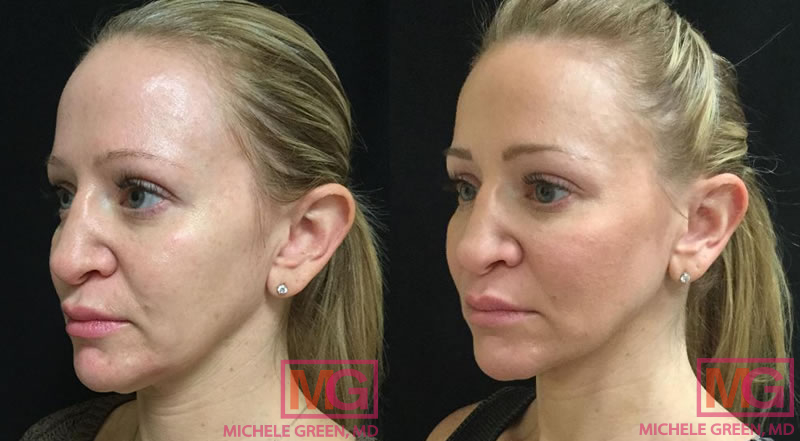
35-44 year old female, Fraxel before and after (3 weeks)
What are the different types of Fraxel lasers?
Fraxel Repair
The Fraxel Re: pair is an ablative laser that uses fractional CO2 to rejuvenate the skin. Fraxel Repair delivers an intense wavelength of light, breaking up small columns in the outer layer of the skin to stimulate new collagen and elastin production. Fraxel Repair can be used to treat sunspots, uneven skin tone and texture, deep wrinkles, and scarring to produce a rejuvenating effect. Because Fraxel Repair is an ablative laser, significant downtime is associated with the treatment, usually lasting about one week. This more aggressive laser is suitable for skin with severe damage.
Fraxel Restore
The Fraxel Restore is a non-ablative laser that uses Erbium 1550 nm wavelength energy to heat the skin and stimulate collagen synthesis. It is a gentler alternative to Fraxel Repair, so it is effective in treating moderate skin damage, such as fine lines, pigmentation, and uneven texture. There is little downtime associated with Fraxel Restore, which usually lasts 1 to 2 days.
Fraxel Dual
The most popular type of Fraxel laser is the Fraxel Dual laser. Fraxel Dual is the newest version of Fraxel lasers that combines the benefits of both of its predecessors, Fraxel Repair and Fraxel Restore. Fraxel Dual is a non-ablative laser that utilizes two different wavelengths: 1550 nm and 1927 nm. The 1550 nm wavelength Erbium effectively increases collagen production to treat acne scars, surgical scars, fine lines, pore size, and uneven skin texture. The Thulium 1927 nm works superficially, precisely targeting specific chromophores, or colored elements within skin cells, to create a controlled, local thermal reaction to diminish pigmented spots and discoloration. At her private dermatology office in Manhattan’s Upper East Side neighborhood, Dr. Green offers the Fraxel Dual laser treatment to target a wide range of skin concerns and provide patients with optimal rejuvenation results that are natural-looking and long-lasting.
How Does the Fraxel Laser Work?
Fraxel Dual laser is a safe and effective treatment option for skin rejuvenation, providing patients with excellent results with minimal downtime. The Fraxel laser is a non-ablative laser, meaning that the treatment does not remove the outer layer of the skin, resulting in faster recovery times. The Fraxel Dual laser delivers fractional laser energy in microscopic columns that precisely penetrate the inner layers of the skin while leaving the surrounding tissue unaffected. As the wavelengths of laser energy penetrate the skin, they cause controlled micro-injury, which triggers the body’s natural healing response and boosts collagen and elastin production—increased collagen and elastin in the treated area help to create smoother, firmer, more youthful-looking skin. When using the 1927 nm wavelength setting, the Fraxel laser will target and destroy specific chromophores to reduce pigmentation in the skin and eliminate sun spots and age spots. Additionally, the Fraxel Dual is equipped with a Zimmer, which emits cold air simultaneously with the laser and is designed to minimize discomfort. There is little downtime associated with Fraxel, and patients often experience mild redness akin to a sunburn for 48 hours after treatment.
What does Fraxel Laser do?
Fraxel laser is FDA-approved to treat the following skin conditions:
- Acne Scars, especially atrophic or depressed scars
- Surgical scars, post-op scars, scars from injuries
- Fine lines
- Wrinkles
- Enlarged pores
- Sun spots, age spots, and other pigmented lesions
- Sun damage
- Uneven skin tone and texture
- Perioral lines (fine lines around the mouth)
- Periocular lines (fine lines around the eyes)
- Stretch marks
- Actinic Keratosis
Am I a good candidate for Fraxel laser treatment?
The best candidates for Fraxel laser resurfacing are individuals in good general health who desire to address specific skin concerns such as fine lines and wrinkles, freckles, age spots, stretch marks, pore size, or acne scarring. Good candidates for Fraxel treatment should fall somewhere between Fitzpatrick skin types I and III, as patients with darker skin tones are at higher risk for developing unwanted side effects or undesirable cosmetic results if treated with the Fraxel laser due to the interaction between the laser and the skin pigment. Patients with melasma are not good candidates for Fraxel treatment, as laser treatment can entrench the pigmentation deeper into the skin and make the melasma worse.
In order to guarantee safety, efficacy, and optimal results, it is important to have skin rejuvenation treatments with an experienced, board-certified professional, such as board-certified dermatologist Dr. Michele Green in NYC. When you consult with Dr. Green at her boutique dermatology office in Manhattan’s Upper East Side neighborhood, she will collect a thorough medical and family history, physically assess the treatment area, and recommend the treatment options best suited to you depending on your needs, skin type, and skin tone.
How is Fraxel Dual laser treatment performed at Dr. Green’s dermatology office?
The first step in scheduling a Fraxel Dual laser treatment is to consult with Dr. Green at her boutique dermatology office in Manhattan’s Upper East Side neighborhood. Dr. Green will collect a thorough medical history, review any cosmetic procedures you may have previously had, physically assess your skin condition, and discuss your skin concerns and personal aesthetic goals. Photographs will be taken of the treatment area to track your future progress and enhance the discussion of your treatment plan. Once it is determined that the Fraxel laser is the best course of treatment, the procedure may be performed on the same day or scheduled for a later date, depending on preference and time allowance.
One hour before your Fraxel laser treatment, a topical numbing cream should be applied to the skin to help eliminate any potential discomfort that may be experienced during the procedure. After the topical anesthetic cream has been on the treatment area for about one hour, it will be removed, and your skin will be sterilized. For the duration of the treatment session, you’ll wear protective goggles for your eyes. Dr. Green will then perform the Fraxel treatment, passing the handheld device over the skin’s surface to deliver fractionated energy to the dermis. A Fraxel treatment session takes approximately 15 minutes to complete when performed on the face, although larger body areas, such as legs and arms, may take up to 30 minutes or longer to perform. Immediately after the procedure, your skin will feel warm, as if it had a mild sunburn. Cold-water compresses will be applied to the treated area, which can be repeated at home if necessary. Afterward, patients can apply moisturizer but must practice strict sun avoidance.
What are the side effects of Fraxel laser fractional resurfacing?
As a non-ablative laser, Fraxel is associated with much fewer side effects and risks than ablative laser treatments. The most common side effects of Fraxel include a mild amount of swelling, redness, and tenderness in the treated area, which tend to resolve within 48 hours of the treatment. If there is a history of acne breakouts, Dr. Green may prescribe an oral antibiotic to be used immediately after your laser treatment. If there is a history of herpes simplex (cold sores), you may be advised to take Valtrex on the day of the procedure to prevent an outbreak.
It is imperative to research the provider performing your laser resurfacing treatment before undergoing a procedure to get the best cosmetic results. Having laser treatment with an inexperienced or unqualified provider can result in poor cosmetic results and undesired side effects, including hyperpigmentation, hypopigmentation, burning, and scarring. When you have your Fraxel laser treatment with a board-certified dermatologist like Dr. Michele Green in NYC, the risk of experiencing unwanted side effects or poor results is extremely low. Dr. Green is an internationally renowned expert in the field of dermatology with over 25 years of experience providing patients with optimal facial rejuvenation results. She will help you determine which unique combination of non-invasive treatments will best suit your situation.
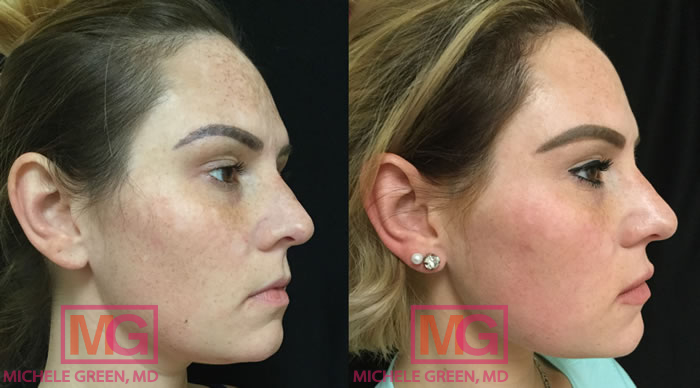
28 year old female, Fraxel & 1 syringe of Juvederm on lips – 4 weeks
What is the downtime for the Fraxel laser?
One of the biggest benefits of the Fraxel laser is that there is minimal downtime and few potential side effects. When Fraxel is performed with the 1550 nm setting, mild redness and swelling for 48 hours are expected. When Fraxel is performed with the 1927 nm wavelength, treatment is associated with an additional 3 to 7 days of peeling, where the skin may feel like rough sandpaper. Patients should avoid picking and scratching at the skin while the treated skin is flaking off. Following treatment, patients should avoid strenuous exercising, hot tubs, and saunas for 48 hours. It is essential to keep the skin moisturized using a plain, gentle moisturizer and to avoid direct sun exposure, as Fraxel treatment makes the skin sensitive to the sun. Patients should use a broad-spectrum sunscreen with an SPF of 50 and wear sun-protective clothing, including a wide-brimmed hat and sunglasses. When you have your Fraxel laser skin resurfacing treatment with Dr. Green at her boutique dermatology office in NYC, she will provide you with all the pertinent aftercare information required for achieving and maintaining the best rejuvenation results.
What skincare should I use after Fraxel?
Proper skin care is essential post-treatment to avoid skin damage and enhance the results of treatment. Patients should avoid the use of hydroquinone, retinoids, or exfoliating products like beta and alpha hydroxy acids for one week post-treatment. After the Fraxel treatment, patients should use a mild cleanser and a gentle moisturizer, such as MGSKINLABS Gentle Cleanser and Absolute Recovery Anti-Wrinkle Cream. You can resume your normal skincare regimen when the treated area is fully healed. Additionally, protecting your skin from the sun after Fraxel laser treatment is essential to prevent sun damage or unwanted side effects, such as worsening hyperpigmentation, burning, or scarring. Dr. Green recommends using a broad-spectrum sunscreen with an SPF of 50 and reapplying it throughout the day as needed. MGSKINLABS Hydrating SPF 50 uses zinc oxide to create a protective barrier on the skin against UV rays, as well as lactic acid and hyaluronic acid to soften and hydrate the skin. To maximize protection, patients can layer both physical and chemical sunscreen onto the skin. Physical sunscreens like the Hydrating SPF 50 use zinc oxide or titanium dioxide to prevent UV rays from penetrating the skin. Chemical sunscreens use agents like homosalate, octinoxate, and avobenzone to convert harmful UV rays into heat energy and dispel them from the skin. Sunscreen should be reapplied every 90 minutes or after engaging in water activities.
How soon can I see the results from Fraxel?
Immediately after a Fraxel laser treatment session, the treated area will exhibit common side effects such as redness and swelling. Patients addressing acne scarring and uneven skin texture with the 1550nm setting may experience mild redness and swelling for up to 48 hours. Those treating sun damage and pigmentation with the 1927nm setting will have an additional 3 to 7 days of shedding dead pigmented skin cells. Results from a single treatment for acne scars or wrinkles using the 1550nm setting will become visible 4 to 6 months later. Patients using the 1927nm setting for sun damage can expect to see results from a single treatment session within four to six weeks. However, patients using the 1550nm setting may only see the complete results from treatment four to six months later. To achieve optimal outcomes, most patients typically need three to six treatment sessions spaced four to six weeks apart.
How many Fraxel treatments are needed?
Some patients may achieve excellent rejuvenation results with only a single treatment session. However, most patients require at least three Fraxel laser treatment sessions, each spaced approximately one month apart, to achieve the best results. Since each Fraxel laser session targets approximately 25 to 40 percent of the treated area at a time, multiple treatment sessions are required to have the best rejuvenation results. While there is an immediate improvement in the first weeks after the laser treatment, new collagen is formed for months after each Fraxel laser treatment for continued rejuvenation. When you have Fraxel laser treatment with Dr. Green, photos will be taken of the treated area before each treatment session to track progress, and she will assess your skin condition to determine approximately how many treatment sessions may be needed for the best cosmetic results.
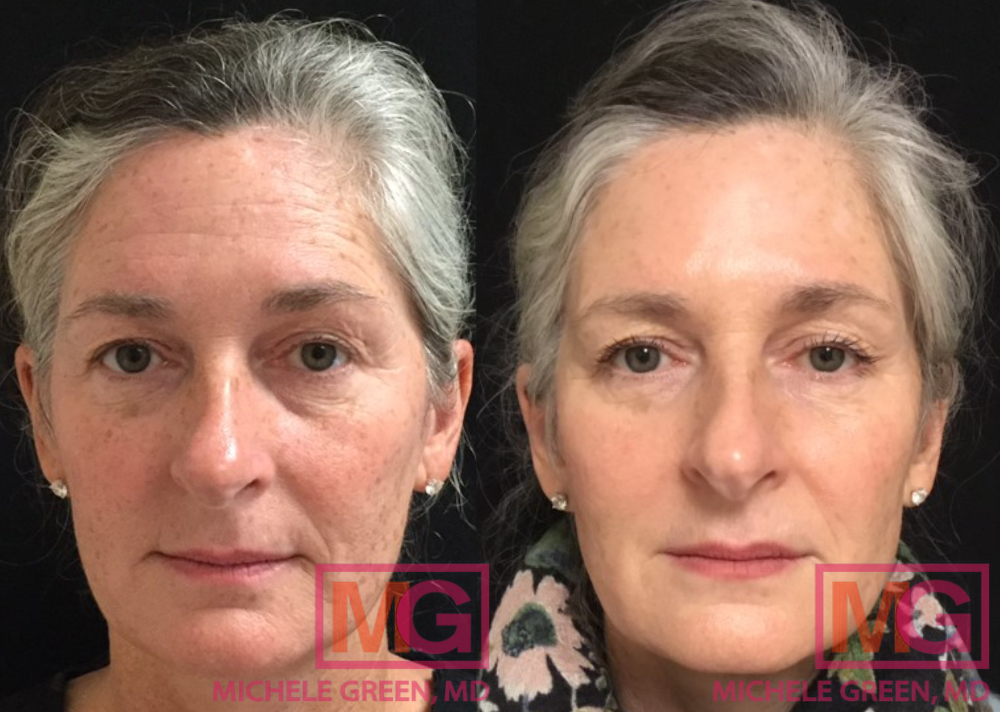
How long do the results of Fraxel last?
Patients in Dr. Green’s office often ask, “How long does Fraxel last?” After a short series of initial treatment sessions, Fraxel produces incredibly long-lasting rejuvenation results. Many patients have enjoyed the cosmetic benefits of Fraxel for years. They can extend the longevity of their results by limiting sun exposure in the treated area and using proper sun protection. Even so, most patients elect to engage in an annual maintenance treatment session to consistently stimulate new collagen production and keep up the best rejuvenation results.
Is Fraxel permanent?
Fraxel provides long-lasting skin rejuvenation and targets a host of different skin concerns, including fine lines, wrinkles, age spots, sun spots, hyperpigmentation, acne scars, large pores, and more. Patients can enjoy the cosmetic benefits of a series of Fraxel treatment sessions for many years; however, Fraxel laser treatment can not prevent new signs of aging from developing. As collagen continues to break down over time due to the natural aging process, new signs of aging can develop in areas that have already been treated with Fraxel. Luckily, engaging with regular maintenance treatment sessions of Fraxel laser can help prevent and treat newer signs of aging. For optimal results, Dr. Green recommends having at least one annual maintenance treatment session. Keeping up with your Fraxel treatments on a yearly basis will keep your skin looking healthy, radiant, and more youthful for longer.
Can I combine Fraxel® with other facial rejuvenation procedures?
Yes! Most patients incorporate Fraxel and a variety of other cosmetic procedures into their personalized treatment plans in order to address a multitude of skin concerns and achieve pan-facial rejuvenation. Some patients may want to treat fine lines and volume loss associated with aging, while others may be more interested in treating redness or skin laxity. The advantage of working with an experienced, board-certified dermatologist, such as Dr. Green in NYC, is that they have the expertise to craft your treatment plan to best meet your particular skin concerns and aesthetic goals.
Botox is considered to be one of the most popular non-invasive procedures in cosmetic dermatology due to its ability to provide consistently stunning results. Botox is used to treat dynamic wrinkles or lines that form due to repetitive facial movements like frowning, squinting, smiling, and raising the eyebrows. Botox is derived from a neurotoxin, botulinum toxin A, that inhibits nerve signaling that tells muscles to contract. When injected into targeted muscles, Botox works to temporarily “freeze” the muscle, inhibiting the muscles from contracting and creating dynamic wrinkles. Botox is FDA-approved to treat lines on the forehead, around the eyes (crow’s feet), and between the eyebrows (glabellar lines). As Botox lasts for three to four months, patients engage in regular maintenance sessions to keep and enhance the results from treatment.
Dermal fillers are injectables used to restore lost volume in the face and create a more youthful-looking appearance. Dermal fillers can be injected into the cheeks, midface, chin, jawline, lips, and many other areas to address age-related volume loss. Fillers like Juvederm and Restylane are comprised of hyaluronic acid, a naturally occurring substance that provides the skin with suppleness and hydration. Hyaluronic acid fillers create immediate results and can last for six to twelve months, depending on the exact filler used. Sculptra is a unique dermal filler that is comprised of poly-L-lactic acid to stimulate new collagen production in the injected area. After an initial series of injections, Sculptra results can last up to two years.
The VBeam laser is often paired with Fraxel treatment due to its ability to eliminate facial redness with zero downtime. The VBeam laser operates on a specific wavelength, 595 nm, that targets the red pigment in the skin. VBeam is an effective treatment option for rosacea, broken blood vessels, stretch marks, post-inflammatory hyperpigmentation, surgical scars, and other skin conditions associated with visible redness. Most patients require a short series of VBeam laser treatments to attain optimal rejuvenation results. Patients appreciate the fact that there is zero downtime involved with the VBeam, meaning they can immediately resume their usual daily activities following each treatment session or safely have the Fraxel laser treatment right afterward.
Thermage radiofrequency laser treatment is one of the most common procedures to be combined with Fraxel skin resurfacing treatment and is considered the gold standard for non-invasive skin tightening. Thermage relies on radiofrequency energy to deliver heat to the dermal layers of the skin, triggering new collagen production to firm, smooth, and tighten the skin. One of the greatest advantages of Thermage is that there is zero downtime involved, which means patients can resume their normal daily activities immediately afterward. Results with Themage take approximately two to four months to become visible, after which they last for up to two years. Most patients opt to have an annual maintenance treatment session to keep up the best results.
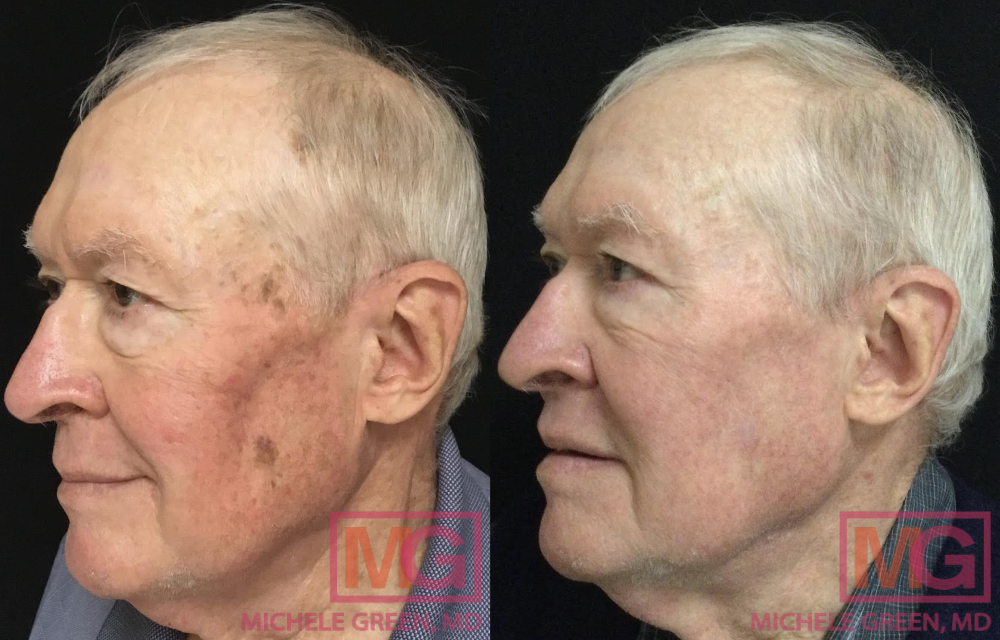
Fraxel Laser FAQs
What are the benefits of Fraxel Dual treatment?
Fraxel is a fantastic skin resurfacing laser treatment designed to address various issues related to skin texture, sun damage (sun spots), age spots, brown spots, fine lines and wrinkles, and surgical scars. This revolutionary laser treatment also diminishes the appearance of crow’s feet and brown spots, improves stubborn acne scars, and creates a rejuvenated, healthy-looking complexion that lasts. Unlike other ablative treatments, Fraxel treatments do not harm the top layer of skin, allowing for stunning rejuvenation results with little downtime. Another bonus is that the Fraxel laser can be used on various areas of the body, including the neck, chest, decolletage, arms, legs, hands, and back.
What is the difference between Fraxel laser treatment and other skin resurfacing lasers?
The Fraxel laser uses non-ablative, fractional laser technology for skin rejuvenation. In the past, the primary type of laser utilized for skin resurfacing was ablative. Ablative laser treatments essentially create an open wound by removing the outermost layers of the skin (epidermis) and heating the underlying skin (dermis). This ablation creates a controlled thermal injury to the skin. As the top layer of skin regrows, new collagen fibers are generated, and the treated skin becomes smoother. However, due to the thermal injury created with ablative lasers like carbon dioxide or CO2 lasers, there is significant downtime as the skin takes time to heal.
Non-ablative lasers, like the Fraxel laser, can stimulate new collagen and improve skin tone and texture with minimal recovery time because of the revolutionary fractionated laser technology. The Fraxel laser treats highly targeted areas while leaving surrounding skin untouched, promoting faster healing and less downtime. This approach to laser skin resurfacing gives Dr. Green greater precision while minimizing the risk of complications and unwanted side effects. The minimal downtime associated with Fraxel is also convenient for patients with busy lives who cannot set aside many days to heal. At her private dermatology office in New York City, Dr. Green offers the Fraxel Dual laser treatment, which operates on two distinct wavelengths to address a wide range of skin concerns effectively.
How deep does the Fraxel laser go?
The depth of Fraxel treatment depends on the wavelength being used, as the 1550 nm wavelength setting penetrates deeper into the skin than the 1927 nm wavelength setting. The Fraxel Dual laser typically penetrates the skin at a depth between 1.5 mm and 1.7 mm. An experienced board-certified dermatologist like Dr. Green will adjust the laser settings to suit your specific skin tone, type, and concerns best.
Does Fraxel help with wrinkles?
Yes! The Erbium 1550 nm setting on the Fraxel Dual laser is excellent for treating wrinkles and lines on the skin. Fraxel treatment triggers the wound healing process and the production of new collagen. Collagen is an essential protein that provides the skin with structure and elasticity. By increasing collagen levels in the skin, the Fraxel laser is able to smooth the appearance of wrinkles and create a more even skin texture. However, dynamic wrinkles created by repetitive facial movements may be better treated with Botox injections, which prevent targeted muscles from contracting and creating wrinkles. Deep wrinkles with associated volume loss may be better treated with dermal fillers to restore lost volume and smooth out facial wrinkles. Patients often combine Fraxel, Botox, and dermal filler treatments to achieve pan-facial rejuvenation. When you consult with Dr. Green in her private dermatology office, she will assess your facial wrinkles and devise a treatment plan to treat your wrinkles and create a more youthful-looking appearance.
Can Fraxel laser treat my acne scars?
Yes! Fraxel laser is amazing at treating many different types of atrophic or depressed acne scars. Atrophic scars are created when inflammation from an acne lesion causes irreparable damage to underlying scar tissue. The inflammation also damages the skin’s wound-healing process, resulting in impaired collagen production. When too little collagen is produced, depressed or atrophic scars form. By stimulating collagen production, the Fraxel laser works to smooth the skin and reduce the appearance of acne scars. Patients often require a series of three to five treatment sessions spaced one month apart to improve the appearance of acne scars effectively.
Does Fraxel tighten skin?
Fraxel is an excellent laser treatment for improving skin tone and texture and reducing fine lines and wrinkles around the face, especially those around the eyes and mouth. It also improves the appearance of acne scars and surgical scars. Fraxel laser treats sun damage and sun spots. Fraxel does produce some skin tightening when new collagen is formed, using the 1550 setting. However, a proper skin-tightening laser, such as Thermage, can provide much greater skin-tightening results. Thermage is the gold standard in terms of non-invasive skin-tightening. It utilizes radiofrequency technology to deliver heat to the dermal layers of the skin, where it stimulates new collagen production to tighten the skin in the treated area and provide a more youthful appearance. The skin rejuvenation benefits of Thermage are gradual, initially becoming visible about six weeks after the treatment and continuing to take effect for up to six months. Patients appreciate the fact that they can achieve incredibly long-lasting results, with the effects remaining for up to two years. Most patients, however, elect to engage in an annual maintenance treatment session of Thermage to keep up with the best results. Many patients combine Thermage and Fraxel treatments into their treatment plans to target a variety of skin concerns and achieve pan-facial rejuvenation with minimal downtime.
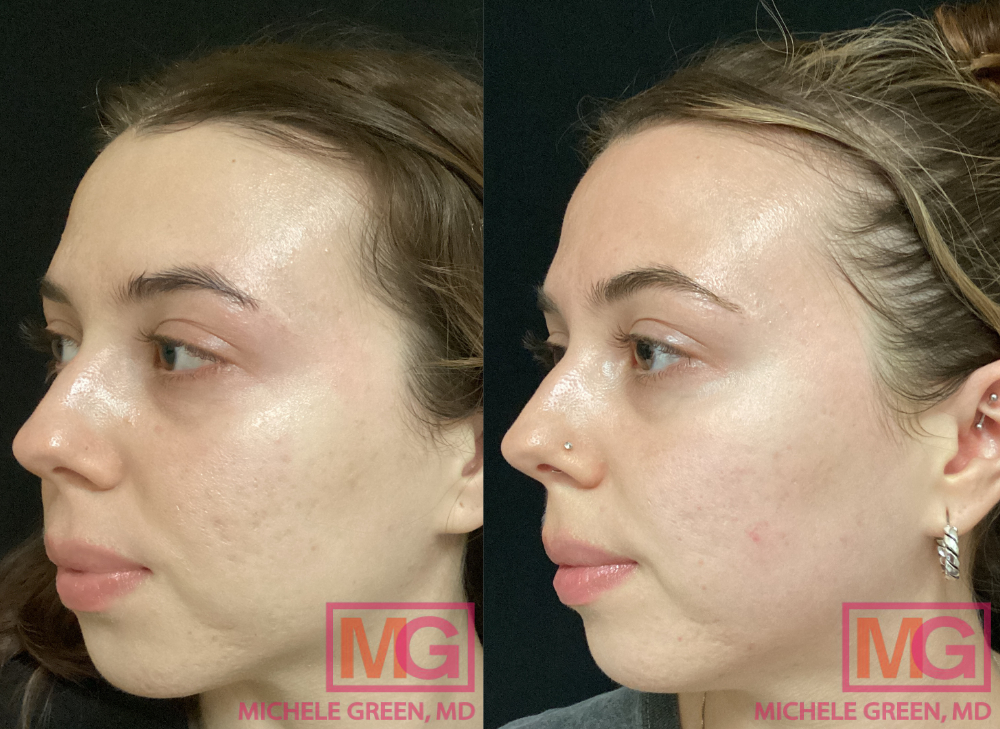
Does Fraxel help with melasma?
No, patients with melasma should do their best to avoid having any laser skin resurfacing treatment, including the Fraxel laser. Laser treatment can actually worsen the appearance of hyperpigmentation associated with melasma. Melasma can still be treated if a patient has been treated with a laser, though it is often much more challenging to diminish. Treating melasma through topical treatments such as chemical peels or Cosmelan is best. If melasma is a skin concern that you would like to address, or if you are unsure whether the hyperpigmentation that you are experiencing is, in fact, melasma, consult with Dr. Michele Green in NYC. Dr. Green has over 25 years of experience treating patients around the globe for many skin conditions, including melasma and other forms of hyperpigmentation.
How long does Fraxel take?
A single Fraxel session takes approximately 15 minutes to complete. The length of time for treatment will depend on the area being treated, as areas such as the back take longer to treat than areas like the face.
How often can I do the Fraxel laser?
Patients must first undergo a series of initial Fraxel treatment sessions in order to see the best cosmetic results. Patients treating sun damage and discoloration may need three treatments spaced one month apart, while patients treating uneven texture and acne scars may need three to five treatments spaced one month apart. Afterward, most patients engage in annual or biannual treatment sessions to keep up and maintain results.
How long between Fraxel treatments?
Patients must wait at least four weeks or one month between each treatment session. Waiting allows for the skin to heal and for collagen to be properly remodeled before another treatment.
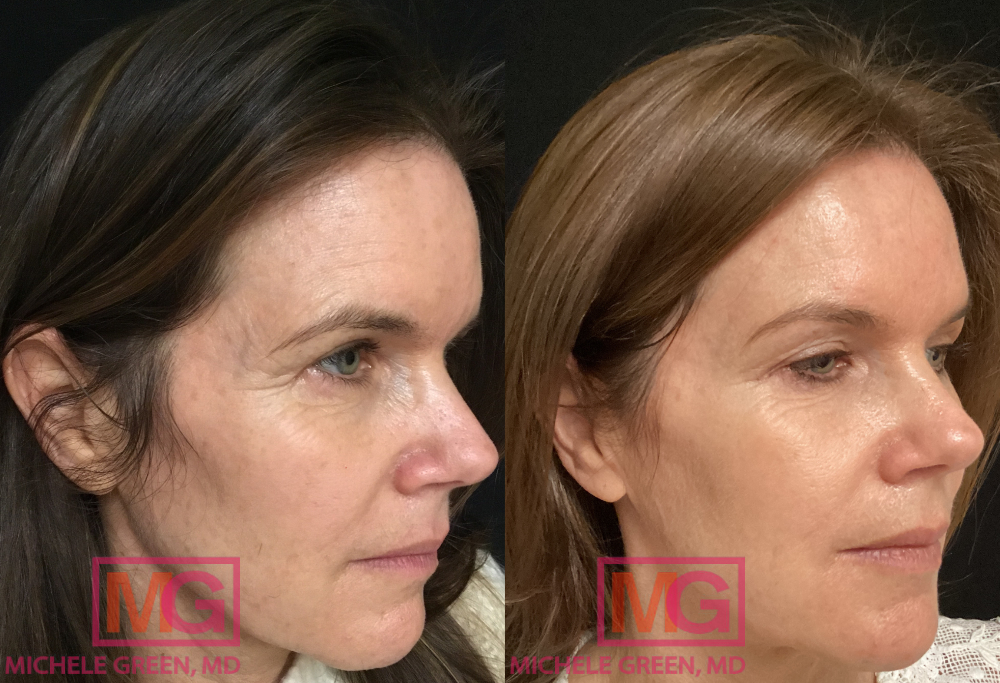
How many sessions of Fraxel do you need?
The number of Fraxel sessions needed depends on the skin concern being treated and the severity of the skin concerns. Three sessions are typically needed to treat pigmented lesions and sun damage, while three to five sessions may be needed to treat acne scars, uneven skin texture, wrinkles, and enlarged pore size. Patients with deeply entrenched pigmentation, severe scars, or uneven texture may require more sessions to see the best cosmetic results. When you consult with Dr. Green at her private dermatology office in the Upper East Side neighborhood of Manhattan, she will work with you to determine a treatment timeline that will leave you with clear, radiant skin.
How much does a Fraxel laser cost?
Fraxel laser costs vary based on geographic area, the area of the body treated, how many areas are being treated in a single session, how many treatment sessions are required to achieve the desired results, and the expertise of the provider. Generally, an experienced board-certified dermatologist or plastic surgeon will be more expensive than going to a MedSpa. However, it is essential to have treatment performed by an expert like Dr. Green, as the risk of encountering dangerous and unwanted side effects, including hyperpigmentation, hypopigmentation, burning, and scarring, is significantly higher when you have laser treatment with an inexperienced or unqualified provider. When you consult with Dr. Green, she will assess your medical history and skin concerns and develop a customized treatment plan to rejuvenate your skin. At this time, the cost of treatment will be discussed.
Does insurance cover Fraxel laser?
Health insurance typically does not cover Fraxel laser treatment, as the procedure is considered to be cosmetic. However, it is always recommended to ask your insurance provider if they will cover any treatment sessions.
Does Fraxel hurt?
No. Fraxel laser treatment is a safe and effective option with almost no discomfort and little downtime. Dr. Green prescribes a topical numbing cream to her patients, which should be applied to the treatment area one hour before their Fraxel treatment to minimize any discomfort. During the procedure, most patients report feeling some minor stinging or heat sensation, with no pain. Immediately after the laser treatment, a cool compress is applied to the treated area to mitigate any residual heat sensation.
Does Fraxel laser cause fat loss?
No, Fraxel does not cause any unintended fat loss in the treatment area. Fraxel delivers fractionated energy to the dermal layer of the skin to stimulate collagen production and improve skin texture and tone. The fractionated energy does not penetrate deep enough into the skin to induce any form of fat loss.
Is Fraxel laser ablative?
No, Fraxel is a non-ablative laser treatment, meaning it removes the entire surface layer of the skin. Ablative lasers can provide dramatic results but are associated with more significant downtime and a higher risk of side effects. Non-ablative lasers like Fraxel stimulate new collagen production in the dermal layers of skin, leaving the outermost layer intact. This feature allows Fraxel to provide optimal rejuvenation results with minimal downtime, which most patients prefer.
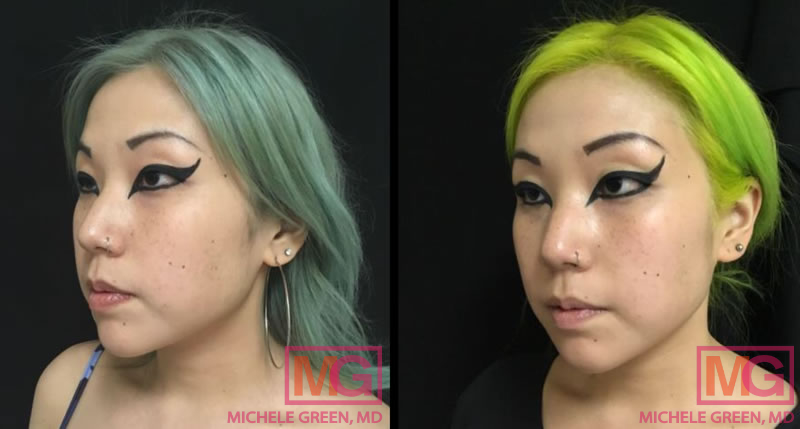
Is Fraxel a CO2 laser?
The CO2 laser and Fraxel laser are two different types of skin-resurfacing treatments that can address a variety of skin concerns, including hyperpigmentation, acne scars, sun damage, fine lines, surgical scars, and enlarged pores, among others. A CO2 laser uses ablative laser technology and removes the outermost layer of the skin to resurface the skin. The Fraxel laser uses non-ablative laser technology and stimulates new collagen production in the dermal layers of the skin. Both laser treatments can be used to target various skin concerns, including sun damage, acne scars, stretch marks, and fine lines, among others. As an ablative laser treatment, the CO2 laser is associated with longer downtime and more discomfort than the non-ablative Fraxel laser treatment. CO2 laser treatment is also associated with a higher risk of hyperpigmentation, hypopigmentation, or scarring after treatment due to its aggressive nature.
Which is better, Fraxel or CO2 or Halo or Moxi laser?
With so many laser treatment options available, it can be hard to know which laser is best for your specific skin concerns. Fraxel, CO2, Halo, and Moxi are all different skin resurfacing lasers that work to stimulate collagen production and improve uneven skin texture and tone, acne scars, sun spots, and fine lines. The CO2 laser is an ablative laser that removes the epidermal layer of skin to rejuvenate the skin. The Halo laser is a hybrid laser that combines ablative and non-ablative technology, removing the top layer of skin while also penetrating the dermis. The Moxi laser is a non-ablative laser that uses fractionated energy, similar to the Fraxel laser.
Patients often prefer the Fraxel laser to the CO2 or Halo laser due to its ability to improve signs of aging without harming the top layer of skin or having prolonged recovery times. While the Moxi laser is a non-ablative laser, it only treats the skin with a 1927 nm wavelength setting. Alternatively, Fraxel Dual employs both a 1550 nm and a 1927 nm wavelength, allowing it to treat skin texture and tone effectively. With little downtime and no side effects, the Fraxel Dual laser is an excellent treatment option for erasing signs of aging from the skin. If you are interested in Fraxel laser treatment, consult with experienced board-certified dermatologist Dr. Michele Green in New York City. A professional in cosmetic dermatology, Dr. Green has the expertise required to recommend the various treatment options, including laser treatments such as Fraxel, that will provide you with optimal rejuvenation results with minimal downtime and leave you looking and feeling like the best version of yourself.
Is Fraxel safe?
Absolutely! Fraxel is FDA-approved for treating fine lines, wrinkles, sun spots, age spots, pigmentation, acne scars, stretch marks, and uneven skin texture and tone. FDA approval ensures that the safety and efficacy of the laser have been well-researched and studied. A little downtime is associated with Fraxel treatment, as patients may experience mild redness or swelling for 48 hours post-treatment. Treatment with Fraxel is incredibly safe, especially in the hands of an expert, board-certified dermatologist like Dr. Green, who has the knowledge and expertise to adjust treatment to each patient’s specific skin concerns, type, and tone.
Is Fraxel worth it?
Yes! Due to the minimal downtime, few potential side effects, ease of having the laser treatment, and consistently stunning rejuvenation results, patients agree that Fraxel with Dr. Green is absolutely worth it! Dr. Green treats some of the world’s most discerning individuals with Fraxel laser treatment to rejuvenate the skin and erase signs of aging. Fraxel effectively targets a wide range of skin concerns, including sun damage, acne scars, fine lines, and sunspots, among others. Commitment to a short series of treatment sessions, each spaced approximately four weeks apart, yields outstanding rejuvenation results. Fraxel replaces aging, damaged skin with new, healthy skin cells for a more youthful, radiant complexion that lasts. When you consult with Dr. Green at her boutique dermatology office in Manhattan’s Upper East Side neighborhood, she will work with you to develop a treatment plan that suits you best.
How do I get started with Fraxel laser treatments today?
Fraxel is a non-ablative skin resurfacing laser treatment that works to rejuvenate the skin without harming the top layer of the skin. Its 1550 nm wavelength setting can treat uneven skin texture, wrinkles, acne scars, stretch marks, and enlarged pores, while its 1927 nm wavelength setting can treat sun damage, discoloration, and pigmentation. Dr. Green often touts the Fraxel laser as a “magic eraser” due to its ability to eliminate signs of aging and create consistently stunning results with minimal downtime. If you are experiencing uneven skin texture and tone and are ready to achieve clear, radiant skin with Fraxel, Dr. Green is here to help.
Dr. Michele Green is an internationally renowned board-certified dermatologist with over two and a half decades of experience providing some of the world’s most discerning individuals with the best non-invasive treatment options for rejuvenation, including Fraxel laser treatment. Dr. Green takes a holistic approach and embraces a less-is-more philosophy regarding facial rejuvenation, customizing each patient’s treatment plan to include a combination of in-office cosmetic procedures and specially formulated skincare products that are best suited to their particular skin concerns and aesthetic goals. She is consistently identified as one of New York City’s best dermatologists by Castle Connolly, New York Magazine, Super Doctors, and The New York Times for her dedication to her patients and expertise. To learn more about the rejuvenation benefits of Fraxel and develop your personalized treatment plan to look and feel like the best version of yourself, schedule a consultation with Dr. Green today by contacting us online or calling 212-535-3088.
 212-535-3088
212-535-3088